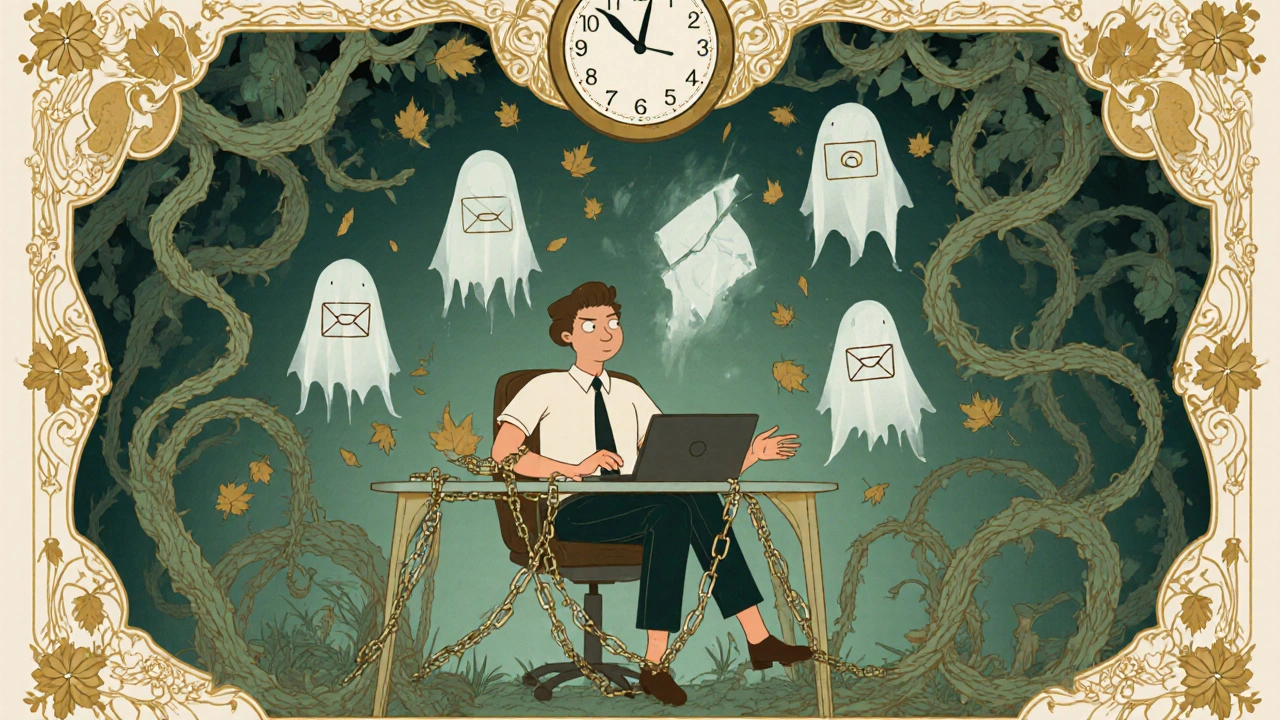Workplace Stress and Burnout: Proven Prevention and Recovery Strategies for 2025

Nov, 22 2025
Workplace burnout isn’t just feeling tired. It’s a slow collapse.
You’re not lazy. You’re not failing. You’re just exhausted-physically, mentally, emotionally. You used to look forward to Monday. Now, Sunday night feels like a funeral. You check emails at 11 p.m. because you think you should. You skip lunch because there’s no time. You nod along in meetings, but your mind is miles away. This isn’t normal. This is burnout-and it’s not your fault.
The World Health Organization officially recognized burnout as an occupational phenomenon in 2019. It’s not a personality flaw. It’s a response to chronic, unmanaged workplace stress. Three signs define it: constant exhaustion, emotional distance from your job, and feeling like you’re no longer good at what you do. According to Gallup’s 2023 data, 23% of workers globally say they’re burned out very often or always. That’s more than one in five people. And in the U.S., 77% of workers felt work-related stress in the last month. The cost? Over $322 billion a year in lost productivity, absenteeism, and healthcare.
What’s really causing your burnout?
Most people blame long hours. But the real culprits are deeper-and they’re systemic.
- Excessive workload (cited by 67% of employees) isn’t just about volume. It’s about lack of control. You’re drowning, but no one lets you drop anything.
- Lack of fairness (34%)-whether it’s unequal pay, inconsistent recognition, or favoritism-erodes trust faster than overtime.
- Breakdown of community (38%) means you feel isolated, even in a crowded office. No one asks how you are. No one remembers your name.
- Conflicting values (29%) happen when your job asks you to do things that go against your ethics. Selling something you don’t believe in? That’s soul-deep stress.
These aren’t random complaints. They’re part of the Job Demands-Resources model, developed by Arnold Bakker and Evangelia Demerouti. When demands (workload, pressure, chaos) outweigh resources (control, support, meaning), burnout follows. And here’s the truth: no amount of yoga or meditation fixes a broken system.
Prevention starts with managers-not mindfulness apps
Organizations spend billions on wellness programs. But the real leverage point? Managers.
Gallup found managers account for 70% of the difference in employee engagement. That means your manager’s behavior is the biggest predictor of whether you’ll burn out. So what do effective managers actually do?
- Five coaching conversations: They talk about your strengths, your purpose, your wellbeing, your growth, and your wins. Not just tasks. Not just deadlines. You. Teams with managers who do this see 41% less burnout.
- Weekly 1:1s that actually matter: No more status updates. Ask: “How are you really doing?” “What’s draining you?” “What would make this easier?” Companies like Unilever and Johnson & Johnson saw 28% higher retention after making mental health part of these check-ins.
- Psychological safety: Google’s Project Aristotle showed teams where people feel safe to speak up, make mistakes, and ask for help have 47% less burnout. That means no fear of looking weak.
And here’s the kicker: 68% of burnout prevention programs fail because managers aren’t held accountable. The solution? Make wellbeing a formal part of their performance reviews. At companies that did this, success rates jumped from 12% to 30%.

Boundary-setting isn’t selfish-it’s survival
You can’t out-willpower a broken system. But you can protect your energy.
- Digital sunset: Automatic shutdowns of work apps after hours. Companies that use this report 31% less after-hours communication and 26% lower burnout.
- No emails after 6 p.m.: Employees who set and enforce this boundary report 39% lower burnout, according to the American Psychological Association.
- Work-from-home Wednesdays: A simple policy at one company reduced burnout by 27%. Flexibility isn’t a perk-it’s a buffer.
- Bookending your day: A 15-minute walk before and after work. MIT’s 2024 study found this cut stress levels by 22% for remote workers. It signals to your brain: work is over. You’re safe now.
These aren’t “nice-to-haves.” They’re non-negotiable. And you don’t need permission to set them. You need courage-and maybe a manager who’s willing to listen.
Micro-breaks and movement: Small shifts, big impact
You don’t need a full-day retreat to reset. Tiny changes add up.
- 5-10 minute breaks every 90 minutes: Keystone Partners found this reduces burnout markers by 17% and boosts productivity by 13%. Walk around the block. Stare out the window. Breathe.
- Walking meetings: Used by 68% of Fortune 500 companies, they cut sedentary time by 27 minutes per day. Moving your body moves your mind.
- Hydration and protein snacks: Fatigue isn’t always mental. Low blood sugar and dehydration make stress worse. Companies that offer water stations and healthy snacks report 19% fewer fatigue-related absences.
- Time-blocking: Schedule deep work, breaks, and admin time. Neurobloom Colorado’s study of 1,200 knowledge workers showed this improved task completion by 28% and cut burnout symptoms by 22%.
These aren’t distractions. They’re recovery tools. Your brain isn’t a machine. It’s a living system that needs oxygen, rest, and rhythm.
Recovery isn’t about “taking a break”-it’s about rebuilding
If you’re already burned out, rest alone won’t fix it. You need structure.
- Strategic disengagement: The APA recommends a 48-72 hour digital detox. No work emails. No Slack. No checking in. In studies, this improved emotional exhaustion by 63%.
- Use your mental health benefits early: Employees who seek help within 14 days of noticing symptoms recover 82% faster than those who wait. Don’t wait until you’re broken.
- Gratitude and accomplished lists: Instead of listing what’s left to do, write down what you’ve already done. Keystone Partners found this cuts return-to-productivity time by 3.2 weeks.
- Workload adjustment: Gallup’s three-phase recovery plan: Recognize (spot the signs), Intervene (temporarily reduce demands), Restore (return with protected time). No one recovers while still drowning.
Recovery isn’t a vacation. It’s a reset. And it requires permission-from yourself and your organization.

The biggest myth: Self-care fixes burnout
You’ve heard it: “Just meditate more.” “Get more sleep.” “Try yoga.”
Here’s the hard truth: self-care addresses only 20% of burnout causes, according to the American Psychiatric Association. The rest? Broken systems. Toxic cultures. Unrealistic expectations. No amount of bubble baths will fix a manager who never listens. No journaling will undo a workload that’s 200% too high.
Dr. Christina Maslach, who created the gold-standard burnout assessment tool, says it plainly: “Burnout is not an individual failure. It’s a systems failure.”
That means real change doesn’t come from apps or retreats. It comes from policy: fair workloads, clear roles, psychological safety, and leadership that owns the problem.
What’s changing in 2025-and what you can do now
The future of work is being rewritten. And you’re not just a worker-you’re part of the change.
- AI burnout predictors: By late 2025, 65% of Fortune 500 companies will use AI to scan emails, calendars, and login patterns to flag at-risk employees-with 82% accuracy.
- 4-day workweeks: Companies like Basecamp and Shopify are leading the way. By 2025, 37% of tech firms will trial it. Productivity didn’t drop. Burnout did.
- HRV monitoring: Heart Rate Variability trackers (used by Google and Intel) measure your body’s stress response. They’re 29% more effective than traditional methods at reducing burnout.
- Right to disconnect: The EU’s 2023 law made it illegal to contact employees after hours. In France, after-hours messages dropped by 37%.
You don’t have to wait for your company to catch up. Start small. Say no. Block time. Walk before work. Ask for help. Document what’s overwhelming. Share it with your manager. You’re not asking for a favor. You’re asking for a sustainable job.
Final thought: You deserve to work without breaking
Burnout isn’t a badge of honor. It’s a warning sign. And the fact that you’re reading this means you’re ready to change.
It’s not about working harder. It’s about working differently. Protect your time. Demand fairness. Speak up. Use your benefits. Set boundaries. And remember: your worth isn’t tied to your output. Your value isn’t measured in hours logged. It’s measured in how you feel when you wake up-and whether you still believe your work matters.
That’s not weakness. That’s wisdom.
